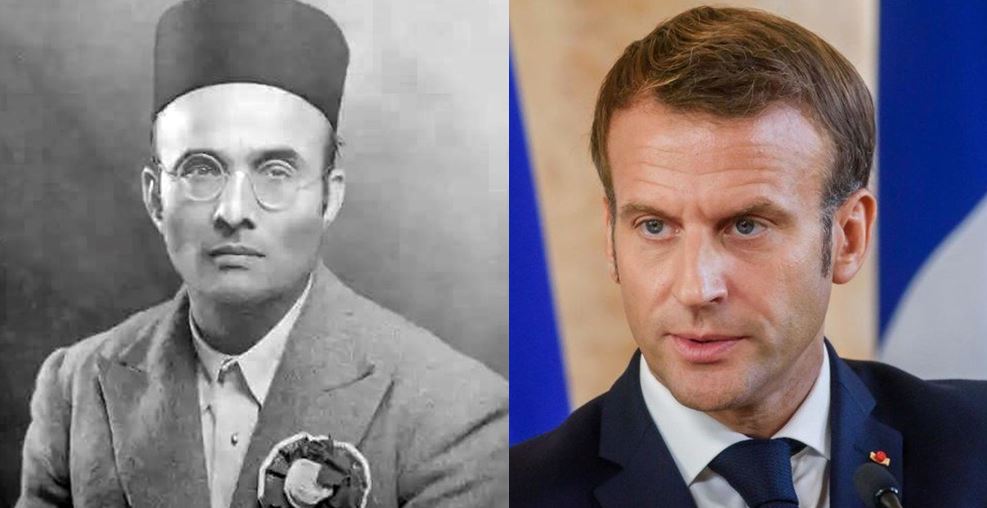“Mohammedan or Christian communities possess all the essential qualifications of Hindutva but one and that is that they do not look upon India as their Holyland,” argued Savarakar in “Hindutva: Who Is a Hindu?” that was published in 1923 and reprinted in 1928. The book, in the last century, has become a holy text for all those who rally behind the Hindutva cause.
Savarkar’s Hindutva
According to Savarakar, the loyalties of the radical Muslims, irrespective of the place they are born and live, lie in Mecca and Medina- which were under the Ottoman Empire, on which Erdogan fashions modern Turkey, till 1916- because they see these cities as their “holy land”. Similarly, the loyalties of Christians lie with Rome because they see it as their “holy land”.
“Aasindhu sindhu paryantaa Yasya Bharata Bhoomika/Pitrubhu Punyabhuchaiva Tavai Hinduriti Smritah,” which basically translates into, “Those who acknowledge the land of Bharata from the Sindhu [Indus] River to the Sindhu [Indian] Ocean as their fatherland and their holy land are called Hindus,” wrote Savarkar in ‘Hindutva: who is a Hindu’, in order to unite all the sects and branches under one umbrella and provoke them to fight against the enemy- British and Muslim separatists.
France’s Problem:
Being the visionary leader that he was, Savarkar saw the problems of the Muslim community almost a century ago. Now, after a radicalized terrorist stabbed a school teacher in France for showing cartoons of Prophet Mohammed, French President, Emmanuel Macron, is talking about the similar problems- loyalty to Mecca and Medina instead of French Republic- of the Muslims society.
Macron talked about how the Muslims in France are trying to create “parallel society” and promoting “Islamic Separatism” within the country. “A parallel order, to erect other values, develop another organisation of society, separatist at first, but whose final goal is to take control. And this is what makes us reject freedom of expression, freedom of conscience, the right to blasphemy,” said Macron in a speech delivered a few days before the beheading of Samuel Paty.
France is facing the challenge of “Islamic separatism” today but the same disease had led to the division of India and creation of Pakistan, the holy land for Muslims, in 1947. India’s ‘experience’ with Islamic separatism is seven decades old compared to France. The country lost a large chunk of its land size, resources, and population because Muslims wanted a seperate nation for themselves. Pakistan and Bangladesh, which used to be part of India till 1947, are today separate nations with Islam as their state religion. This is what the disease of “Islamic separatism” can do- division of a country into three.
Macron can foresee the “parallel order” agenda of the radical Muslims of France and has vowed to crack down on separatist elements. Savarkar, like Macron, foresaw the problem 24 years before it led to the division of the country, but unfortunately, unlike Macron, he had no executive power except to urge Hindus to unite.
Holy Land:
Migration is the truth of human society. Human beings migrate essentially in two ways with the first being as a ‘ruling force’ in which they impose their ideals and customs on the native population and the other being ‘opportunity seeker’ in which they try to assimilate themselves with the law of the land while maintaining their unique identity. Today, the majority of the migration around the world is of second type.
In the US, the biggest receiver of migrant population, the term “Americanization” is very popular in the intellectual and commoner discourse. Americanization essentially means that a migrant would learn English language and learn to adjust as per American culture, values, and customs. Similarly, European countries which receive a large influx of migrant population, try to “homogenize” them with native people.
But, many Muslims, even if they go to a country under the second type of migration, do not try to assimilate themselves with the native population. Instead, they try to create a “parallel society” as per their values and then try to enforce it on native population. The attacks on females wearing short dresses in France is an example of the same mindset. When their values conflict with that of the native population, some leaders of the Muslim society call of “separatism”.
The holy land for Muslims remains Mecca and Medina, and for many, their values are driven by the holy book of the prophet, and legal norms as per Sharia irrespective of the country they live in. The constitution of the country they live in holds very little value for many Muslims. In India, even today, the Muslim society is governed by All India Muslim Personal Law Board- which claims to follow Sharia- and the leaders of the Muslim society oppose Uniform Civil Code (UCC).
The Holy land and holy book for Muslims remains Mecca and Quran irrespective of the country they live in. And, this is the ‘fundamental problem’ with their assimilation.
Conclusion:
Savarkar was a prodigy and an “original thinker” unlike the today’s ‘intellectuals’ who write 11th book by compiling and modifying the contents of 10 books (Ram Guha, who claims mastery from cricket to environment to history being the best example). He composed first poem at the age of 6 and at the age of 26, in 1909, Savarkar published ‘First war of independence’- a seminal contribution to Indian history. He foresaw the threat of “Islamic separatism” 24 years before a separate nation for Muslims was created out of the country and almost a century before French president Emmanuel Macron.
The Congress party, the most powerful native political force of Savarkar’s time, did not respond to Savarkar’s warnings and the nation paid the price through division of the country. Taking a lesson from India’s mistake, the French Republic should rally behind President Macron to save the country from “Islamic separatism”.
